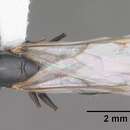en
names in breadcrumbs


Natural History: C. ashmeadi nests above ground and forages mostly in tree canopies and on lianas, in columns up and down tree trunks and vines to gain access to low vegetation. In Forest Park in St. Louis, the arboreal habitat of this species has allowed it to survive the depredations of Tetramorium tsushimae. Like all Crematogaster, this species feeds heavily on the secretions of extrafloral nectaries and honeydew-excreting hemipterans. Workers may also drink fluids from bird droppings on foliage, carrion and other protein-rich tidbits. Sexuals are reared in early summer.
Taxonomic history
Combination in Crematogaster (Acrocoelia): Emery, 1922c PDF: 141.Combination in Crematogaster (Crematogaster): Buren, 1968b PDF: 92.Combination in Crematogaster (Crematogaster): Blaimer, 2012c PDF: 55.Senior synonym of Crematogaster ashmeadi matura: Creighton, 1950a PDF: 206.See also: Johnson, 1988: 315.Morgan & Mackay, 2017 PDF: 73 (q.).
Crematogaster ashmeadi, commonly known as the acrobat ant, is an arboreal ant widespread in the Southeastern United States. It nests and forages almost exclusively above ground level, often found in treetops and on lianas. It is one of eleven species in the genus Crematogaster that is native to eastern North America. This ant species has been observed to raid wasp nests, including the species Mischocyttarus mexicanus, and to forage on their brood.[2] It is the most dominant arboreal ant in the pine forests of the coastal plains of northern Florida.[3] Colonies of these ants inhabit a majority of pine trees in the area, living in chambers in the outer bark of living trees that have been abandoned by bark-mining caterpillars, usually of the family Cossidae. C. ashmeadi does little to no excavation of its own, relying solely on chambers bored out by other insects.[3]
Crematogaster ashmeadi, commonly known as the acrobat ant, is an arboreal ant widespread in the Southeastern United States. It nests and forages almost exclusively above ground level, often found in treetops and on lianas. It is one of eleven species in the genus Crematogaster that is native to eastern North America. This ant species has been observed to raid wasp nests, including the species Mischocyttarus mexicanus, and to forage on their brood. It is the most dominant arboreal ant in the pine forests of the coastal plains of northern Florida. Colonies of these ants inhabit a majority of pine trees in the area, living in chambers in the outer bark of living trees that have been abandoned by bark-mining caterpillars, usually of the family Cossidae. C. ashmeadi does little to no excavation of its own, relying solely on chambers bored out by other insects.